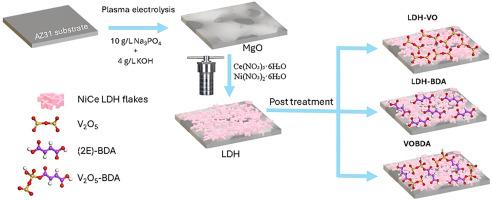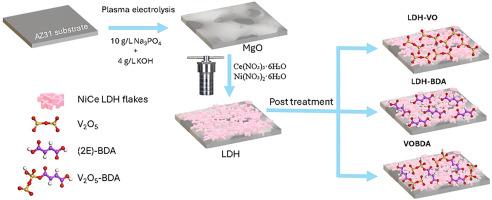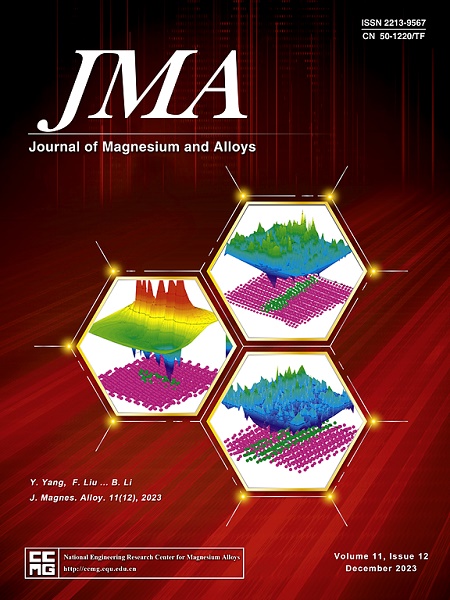用 V₂O₅ 纳米粒子和 (2E)-But-2-enedioic acid 复合物 CeNiLDH 对等离子电解氧化镁进行高级改性,开发高效防腐系统
IF 15.8
1区 材料科学
Q1 METALLURGY & METALLURGICAL ENGINEERING
引用次数: 0
摘要
具有独特性能的先进混合材料对于满足日益复杂的应用需求至关重要。层状双氢氧化物(LDH)与金属氧化物纳米颗粒和二羧酸的自组装尽管非常重要,但由于对其形成机理的了解有限,且难以评估其防腐性能,因此受到限制。在本研究中,我们开发了一种新型防腐体系,将 CeNiLDH 与五氧化二钒(V₂O₅)纳米粒子和 (2E)-2- 丁烯二酸((2E)-BDA)的复合物插层在 AZ31 镁合金等离子电解生成的氧化镁层上。该系统与仅夹有 V₂O₅ 或 (2E)-BDA 的 LDH 薄膜进行了比较。LDH 与 V₂O₅ 和 (2E)-BDA 的插层形成了花状结构,而与它们的复合物的改性则形成了更紧凑的云状结构。这些云状结构由整个分层网络中增强的吸收和稳固的氢键驱动,通过延迟腐蚀性阴离子的移动有效抑制了腐蚀。这体现在极化电阻为 1.51 × 10¹⁰ Ω-cm²,比未改性 LDH 薄膜的电阻(3.41 × 10⁸ Ω-cm²)高出约两个数量级。此外,与未改性的 LDH 样品相比,VOBDA 样品的腐蚀电流密度(icorr)降低了四个数量级,凸显了这种混合涂层卓越的防腐性能。密度泛函理论(DFT)用于阐明 LDH 与无机-有机复合物之间的键合和形成机制。本文章由计算机程序翻译,如有差异,请以英文原文为准。


Developing an efficient anticorrosive system through advanced modification of plasma-electrolyzed MgO with CeNiLDH complexed with V₂O₅ nanoparticles and (2E)-But-2-enedioic acid
Advanced hybrid materials with unique properties are essential for addressing the demands of increasingly complex applications. Despite their importance, the self-assembly of layered double hydroxides (LDH) with metallic oxide nanoparticles and dicarboxylic acids is constrained by a limited understanding of the formation mechanisms and difficulties in evaluating their anticorrosive performance. In this study, we developed a novel anticorrosive system by intercalating CeNiLDH with a complex of vanadium pentoxide (V₂O₅) nanoparticles and (2E)‑but-2-enedioic acid ((2E)-BDA) on a MgO layer created through plasma-electrolysis of AZ31 Mg alloy. This system was compared with LDH films intercalated with either V₂O₅ or (2E)-BDA alone. The intercalation of LDH with V₂O₅ and (2E)-BDA resulted in a flower-like structure, while modification with their complex led to a more compact, cloud-like formation. These cloud-like structures, driven by enhanced absorption and robust hydrogen bonding throughout the hierarchical network, effectively suppress corrosion by delaying the movement of corrosive anions. This was reflected in a polarization resistance of 1.51 × 10¹⁰ Ω·cm², which is approximately two orders of magnitude times higher than the resistance of the unmodified LDH film (3.41 × 10⁸ Ω·cm²). Additionally, the corrosion current density (icorr) of the VOBDA sample showed a decrease by four orders of magnitude compared to the unmodified LDH sample, emphasizing the superior anticorrosive performance of this hybrid coating. Density functional theory (DFT) was used to elucidate the bonding and formation mechanisms between LDH and the inorganic-organic complex.
求助全文
通过发布文献求助,成功后即可免费获取论文全文。
去求助
来源期刊

Journal of Magnesium and Alloys
Engineering-Mechanics of Materials
CiteScore
20.20
自引率
14.80%
发文量
52
审稿时长
59 days
期刊介绍:
The Journal of Magnesium and Alloys serves as a global platform for both theoretical and experimental studies in magnesium science and engineering. It welcomes submissions investigating various scientific and engineering factors impacting the metallurgy, processing, microstructure, properties, and applications of magnesium and alloys. The journal covers all aspects of magnesium and alloy research, including raw materials, alloy casting, extrusion and deformation, corrosion and surface treatment, joining and machining, simulation and modeling, microstructure evolution and mechanical properties, new alloy development, magnesium-based composites, bio-materials and energy materials, applications, and recycling.
 求助内容:
求助内容: 应助结果提醒方式:
应助结果提醒方式:


